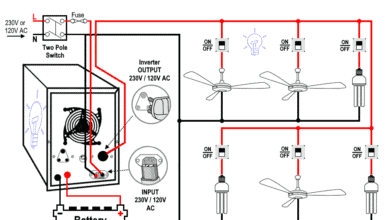Why Doesn’t DC System Require a Grounding System Similar to AC System?
Grounding System in DC Power Supplies and Network – Advantages and Drawbacks
Actually, grounding and earthing are not required for either AC or DC systems to function. However, grounding via the neutral, equipment grounding conductor (EGC), or protective ground wire is necessary and mandatory for personnel and equipment protection against electric shock, as well as for system stability and reliability.
Why Do Some DC Circuits Not Need Grounding?
A DC system often does not require grounding because, unlike AC, it maintains a constant polarity (positive and negative). This eliminates the need for a reference ground point to complete the circuit. This is because the negative terminal effectively acts as the ground within the system. Additionally, the simpler design of properly insulated and isolated DC circuits makes grounding less necessary for basic functionality and safety. This fact is only applicable in basic circuits especially in low-voltage applications like batteries and electronics.
In AC systems, ungrounded conditions can lead to high fault currents, posing significant safety hazards. On the other hand, DC systems, particularly in isolated configurations such as battery-operated or photovoltaic (PV) setups do not inherently generate ground fault currents unless referenced to the ground.
In many DC applications, grounding is either unnecessary or implemented differently from AC systems. Many DC systems, such as those in aircraft, industrial automation, and battery-powered applications, use floating (ungrounded) or isolated grounding configurations, meaning the circuit is not referenced to ground. Floating DC systems can continue operating with a single ground fault, whereas grounded systems may experience immediate faults. This approach is commonly found in:
- Battery-Powered Systems: Portable electronics and vehicles operate on isolated DC supplies.
- Solar Power Systems: PV arrays often function without a ground reference.
- Telecommunication Systems: DC power distribution in telecom networks is typically floating to avoid ground loops and interference.
Related Post: Difference Between AC Ground and DC Ground?
Requirement of DC Grounding
Lower DC voltages, such as 12V batteries, are not dangerous. That is why you typically see only two wires from the battery (i.e. Negative (-Ve) and Positive (+Ve) connecting to the circuit. In a DC system, there are only two paths: the positive conductor and the negative conductor. In contrast, AC voltages such as 120V, 230V, and 240V, which have a high potential for electric shock, must be properly earthed and grounded according to IEC and NEC codes (Article 250).
Grounding is mandatory for higher DC voltages, industrial applications, and hybrid AC/DC systems. NEC 2023, Article 250.162 requires a grounding system for two-wire and three-wire DC systems supplying a premises when the operating voltage is greater than 60V DC and less than 300V DC (*see exceptions in 250.162(A)).
In high-voltage DC (HVDC) transmission systems, a grounding system is essential, similar to grounding and earthing in AC systems. That is why grounding is required for solar panel and battery wiring systems, especially to protect against lightning strikes.
Different between AC and DC Grounding Systems
In an AC system, “grounding” refers to a physical connection with the earth, with the returning path as “neutral,” which is already provided by the utility and transformer. For example, the metallic body of an electrical device is connected to the earth via a grounding or earthing conductor, allowing fault currents to safely return to the source without causing harm.
In a DC system, “ground” refers to a point with zero volts (0V) reference, where power is supplied from rectifiers, and the ±48V output and ground with 0V is physically connected to the earth in AC system. Another term used in DC wiring systems is the “negative circuit path.” A common example is chassis grounding, where the chassis (metal body or frame) of a car is connected to the negative terminal of the battery, acting as a reference ground. However, in combat military vehicles, the negative wire is directly connected back to the source as a dedicated negative path instead of using chassis ground, preventing failure due to corrosion or rust over time.
AC has a frequency and is “transmitted.” It seeks the path of least resistance back to the source. In this way, the “earth/ground” has a lower potential (0V), and the ground conductor with the least resistance is used for “safety.” Hence, the “ground rod and associated wire” provide the easiest path to dispose of any leakage or residual current in the circuit back to the source. This ensures that a person touching a live conductor is less likely to receive an electric shock.
On the other hand, DC is “conducted,” not transmitted. It seeks a polar opposite to complete the circuit—for example, current moves from the positive terminal to the negative terminal (conventional current flow). Providing a ground connection in this configuration is generally ineffective for “safety”.
- Related Post: Difference Between Grounding, Earthing and Bonding
Importance of Grounding in DC Systems
Consider an already completed circuit via DC supply, such as a 12V battery, and you touch either or both terminals, you will not get shocked because the lowest resistance path is through the completed circuit, not through your body. That is why touching 12V car battery terminals with bare hands is harmless, even though the battery has enough current and voltage to be potentially dangerous. The reason is that the battery is connected to all the metallic parts of the car. Even if you touch the car door or any other metallic part (even in the rain or with wet hands) it remains safe because you are not a part of the completed circuit. Additionally, the car is not electrically grounded to the earth due to its rubber tires.
This scenario is only safe as long as you are not completing the circuit yourself. For example, if you hold both terminals of a high-voltage DC battery with your hands, you will receive an electric shock. Similarly, if a high-voltage power line falls onto a car, it will not harm the occupants until they step out and make physical contact with the ground. This is because DC seeks a polar opposite to complete the circuit rather than any available conductor.
Earthing and grounding in DC systems help prevent accidents and hazardous fires. Consider a fault scenario where the negative terminal of a DC source makes contact with the earth or water. If someone is standing on the wet ground, they may receive an electric shock because the path to the source is completed through their body. Similarly, if the positive terminal of the DC source is grounded (earthed) and someone accidentally touches the negative terminal, they will also receive a shock. This is why ground fault protection via GFCIs and RCDs is just as necessary in DC systems as it is in AC systems.
Finally, if a grounding system is absent in DC circuits, ground faults may go undetected cause by additional ground loop in the circuit. Consequently, the fuse or breaker may not trip, leading to the creation of unintended ground loops that can cause circulating currents in the circuit, potentially resulting in unwanted tripping of GFCIs.
When is DC Grounding Required?
While grounding and earthing are mandatory for human safety and the protection of personnel and property, as mentioned above, grounding and a 0V reference in DC systems are also required for several reasons.
- It is a code requirement under NEC 250.162 for DC grounding in 3-wire and 2-wire DC systems operating above 60V and below 300V.
- High-voltage DC (HVDC) transmission systems sometimes use grounding to stabilize potential differences, prevent insulation breakdown, and manage fault currents efficiently.
- Grounding in DC circuits helps accumulate and dissipate excessive charge current. For example, grounding in PV arrays for lightning protection and system stability.
- Industrial applications and sensitive electronic circuits with high DC voltages, such as data centers, require grounding to provide a return path for fault currents and ensure personnel safety.
- Electronic systems sensitive to static discharge often use grounding to prevent damage caused by electrostatic discharge (ESD).
- Systems that integrate both AC and DC components may require grounding to maintain compatibility and ensure safety in case of faults.
- DC grounding also helps minimize electromagnetic interference (EMI) and noise in radio communication systems.
- Telecommunication systems use a -48V DC system referenced to ground for stability and reliability.
- Railway and transit systems use grounding to manage stray currents and prevent track corrosion.
- In vehicles, chassis grounding is used to save money on copper wiring and reduce production costs.
Related Post:
- Is It Possible to Get Electrocuted by an Electric Vehicle?
- Will I Get an Electric Shock If I Touch the Ground Wire?
Advantages of DC Grounding Systems
The primary purpose of grounding in a DC system is safety and protection for both personnel and equipment. For example, if the negative wire from the DC source is grounded via a ground wire, and the positive wire accidentally makes contact with the ground, it will cause the fuse to blow or the breaker to trip. This prevents electric shock for anyone who might come into contact with the live voltage. Additionally, grounding in DC circuits makes it easier to locate and clear faults using DC ground fault relays. This practice avoid creating additional ground loops and current circulation and wastage of stored supply.
If there is a proper grounding system in DC circuits, it is easier to detect the ground faults caused by the additional ground loops and flowing current in the circuit. Hence, in case of fault, it will blow the fuse or trip the breaker.
In a grounded DC system, where the negative (-Ve) output is connected to a bonded ground, common-mode noise is reduced or eliminated. When measuring voltage with a multimeter, if the reference point is stable while the voltage at a junction changes due to interference, the signal will be noisy. However, when both the junction and reference voltage change simultaneously due to interference, the noise is significantly minimized, improving signal clarity.
Additionally, in grounded DC systems, measurements are easier because the chassis or metallic body of the device can be used as a reference point. In ungrounded DC systems, an additional wire connected to the common terminal of the DC source is required for accurate measurement.
- Related Post: What Happens if a Battery is Connected to the AC Supply?
Disadvantages of Grounding in DC Systems
Although grounding a DC supply system is generally preferred, it can also introduce certain issues. For instance, leakage current to ground and ground loop interference in sensors. Industrial DC power supplies are commonly used in control cabinets and various control and protective devices, including controllers, contactors, relays, sensors, circuit breakers, and I/O terminals.
One of the drawbacks of grounding and earthing a DC power supply is floating DC voltage. A DC control system is considered floating when a power supply is energized by an AC line voltage (via Line, Neutral, and Ground), but its DC output is only connected to the Positive and Negative terminals.
For instance, a charger or adapter with a two-prong plug connected to an AC supply typically operates with a floating ground. This is because it only provides Positive and Negative DC output terminals to the load. Additionally, a three-prong plug may have grounding or a capacitively coupled ground, where the AC grounding is connected to the DC protective earth. Alternatively, it may have 2-wire outputs without grounding. Similarly, single-phase or three-phase DC power supplies that receive AC input and provide DC output via Positive (+) and Negative (-) terminals may also operate with a floating ground.
For analog voltage devices with a common reference wire, it is often beneficial to keep the DC power supply floating to avoid ground loops and maintain signal integrity.
In some DC voltage systems, engineers may choose not to ground the DC output. In this configuration, the Negative (-Ve) terminal of the DC supply is not connected to the building’s AC grounding system. However, it’s important to note that NEC-250.162 mandates grounding for DC systems in certain cases. Similarly, UL 508A requires DC grounding for specific applications.
One major drawback of grounding DC systems is ground loop interference. Most industrial devices (such as DC circuit breakers, VFDs, PLCs, etc.) are properly grounded to provide a return path for fault current and ensure safety. However, if the Negative (-Ve) terminal of the DC system is also grounded, it creates two connections to the earth. This case forms an unwanted additional circuit known as a ground loop. For instance, if you don’t ground the encoder case connected through the shielded cable, an additional group loop will occur in the circuit and a small amount of current will start to circulate in it.
Another disadvantage of a grounded DC supply is leakage current to ground, which can cause unwanted tripping of Ground Fault Circuit Interrupters (GFCIs). Many DC power supplies include EMI-filtering capacitors to filter out irregularities caused by the input AC voltage. During switching, these capacitors may generate small transient voltage spikes, leading to a small leakage current. This leakage current becomes noticeable when multiple DC power supplies are used, sometimes causing false tripping of GFCIs and circuit breakers.
Resources:
- Why is the Grounding Wire Bare and Not Insulated?
- Why is the Ground Wire Size Smaller than the Hot Wire?
- Why is the Ground Wire Always Positioned Above the Overhead Power Lines?
- Why Must Neutral and Ground Wires Be Bonded in the Main Panel?
- Why are Neutral and Ground Wires Separated in a Subpanel?
- What Happens if a Power Line Falls into the Ocean Water?
- If Lightning Strikes the Sea, How Far Away is it Dangerous?
- What Happens to the Battery with Reverse Polarity Wiring Connection
- Will a Man Get an Electric Shock If He Hangs on a Live Wire?
- What Happens When an AC Line Touches a DC Line?
- Why are Salt and Charcoal Added in Earthing Pit for Grounding?
- Can the Neutral Wire Cause Electric Shock?
- Which One Kills – Current or Voltage and Why? Amps vs Volts
- AC or DC – Which One is More Dangerous And Why ?
- What Happens When You Touch an Electrical Busbar?
- Why Can’t We Store AC in Batteries instead of DC?
- Which One is More Dangerous? 50Hz or 60Hz in 120V/230V & Why?
- Why Do The Positive And Negative Wires Spark When Touched?
- What Happens if We Connect a Polar Capacitor the Wrong Way?
- Is Lightning AC or DC ?
- Difference Between GND, 0VDC, Common and Virtual Ground







